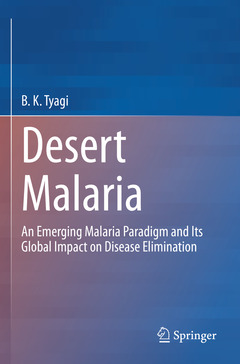Desert Malaria, 1st ed. 2023 An Emerging Malaria Paradigm and Its Global Impact on Disease Elimination
Auteur : Tyagi B.K.

Chapter 1: WORLD MALARIA SITUATION VIS-À-VIS DESERT ECOSYSYEMS
(i) Global malaria scenario
(ii) Asian malaria scenario
(iii) Indian malaria scenario
Chapter 2: DESERTS OF THE WORLD AND RESIDUAL MALARIA SOURCES
(i) Deserts and their malaria history
(ii) Saharan Desert and malaria
(iii) Middle-East Deserts and malaria
(iv) Great Indian Thar Desert and malaria
Chapter 3: ENVIRONMENT OF THE AFRICAN SAHARA AND THE GREAT INDIAN THAR DESERTS
(i) Topography, biota, landscapes, water sources
(ii) Extensive canalization
(iii) Changes in physiographic characteristics
(a) Rise in water table
(b) Rainfall, temperature and humidity
Chapter 4: EXTENSIVE CANALIZATION IN THE AFRICAN SAHARA AND THE GREAT INDIAN THAR
DESERTS
(i) Groundwater quality
(ii) Soil property
(iii) Land irrigability productibility
(iv) Canal sedimentation
(v) Crop pattern
(vi) Demography and human behaviour
(vii) Wetlands and sources of potable water
Chapter 5: ANOPHELINE FAUNA IN THE AFRICAN SAHARA AND THE GREAT INDIAN THAR DESERTS
(i) Classification of Anopheles
(ii) Species Identification and Phylogeny of Anopheles
(iii) Anopheles Species Complexes
(iv) Speciation, plasticity and genetic polymorphism
(v) Diversity Dominant Vector Species(vi) Distribution of the Dominant Vector Species
Chapter 6: EPIDEMIOLOGY OF MALARIA IN THE AFRICAN SAHARA AND THE GREAT INDIAN THAR
DESERTS
(i) Dynamics of malaria prevalence
(ii) Focal outbreaks of malaria
(iii) Urban malaria
(iv) Quarymine malaria
(v) Border malaria
Chapter 7: EPIDEMICS OF MALARIA IN THE AFRICAN SAHARA AND THE GREAT INDIAN THAR
DESERTS
(i) Evolution of pathways of malaria(ii) Epidemics and human behaviour
Chapter 8: AGROECONOMICAL AND SOCIAL IMPACTS ON MALARIA IN THE AFRICAN SAHARA AND
THE GREAT INDIAN THAR DESERTS
(i) Health impact of malaria
(ii) KAP in the Desert
(iii) Paradox about rice cultivation in the irrigated desert region and malaria
Chapter 9: MALARIA MANAGEMENT WITH VECTOR CONTROL IN THE AFRICAN SAHARA AND THE
GREAT INDIAN THAR
DESERTS(i) Environmental control of vectors
(ii) Insecticidal control of vectors
(iii) Biological control of vectors
(iv) Genetic control of vectors
Chapter 10: MALARIA DIAGNOSIS IN THE AFRICAN SAHARA AND THE GREAT INDIAN THAR
DESERTS
Chapter 11: MALARIA IMMUNITY IN DESERT POPULATION IN THE AFRICAN SAHARA AND THE GREAT
INDIAN THAR DESERTS
Chapter 12: MALARIA CONTROL IN THE AFRICAN SAHARA AND THE GREAT INDIAN THAR
DESERTS
(i) Treatment policies
(ii) Antimalarials
(iii) Resistance development in malaria parasites
(iv) Drug pharmacokinetics and delivery
Professor Dr Brij Kishore Tyagi is presently serving as an Advisor to SpoRIC, VIT University, Vellore, TN, India and a tenured International Consultant for Biotech Consortium India Limited on a FAO—Sri Lanka Biosafety Project. During his highly prolific career in the Indian Council of Medical Research, spanning over 35 years, he investigated on malaria in several hyperendemic states like Odisha and Gujarat as well as the inhospitable environments of The Great Indian Thar Desert in Rajasthan. Following his emeritation from the Government of India’s ICMR-Centre for Research in Medical Entomology, Madurai as the Scientist “G” (Director) & Director in-Charge, he was first appointed as a Visiting Fellow at the Department of Biotechnology & Environmental Science, Bharathidasan University, Tiruchirappalli, TN in 2015, and later as a Visiting Professor at the university in 2016. He further took up Visiting Professorship at the Department of Zoology & Environmental Sciences, Punjabi University, Patiala, Punjab for two years (2017-18) and was teaching PG students on medical entomology, parasitology and vector-borne diseases. He has been also serving inter alia as a Core Faculty of the DST-SERB School of Insect Biology at Hyderabad University, Hyderabad and a Guest Faculty, Mohan Lal Sukhadia University, Udaipur. He was the first National Representative in-Charge in India for the International Odonatological Society (1981-1990), and a member in-Charge in South Asia for the Odonata Specialist Group of Species Survival Commission (IUCN) (1985-1995). He is Chief Editor of Journal of Medical Arthropodology & Public Health and editor or member of Editorial/Referee Boards for several international and national journals. He was the Chairman of the Review Committee on Genetic Manipulation (RCGM) of the Department of Biotechnology for the On-Site Inspection Committee for RCT with GM Aedes aegypti at MAHYCO, Jalna, Maharashtra, and an expert member o
Covers epidemiology, diagnosis, and disease dynamics of desert malaria
Discusses response of malaria epidemics to climate forcing
Reviews strategies for the control and management of desert malaria
Date de parution : 02-2024
Ouvrage de 416 p.
15.5x23.5 cm
Date de parution : 02-2023
Ouvrage de 416 p.
15.5x23.5 cm
Thèmes de Desert Malaria :
Mots-clés :
Desert Malaria; Emerging paradigm; Entomology; Parasitology; Epidemiology



